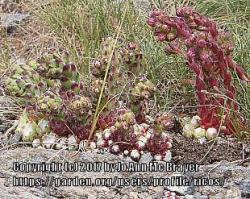Sempervivum and Light
We have seen how temperature affects how Sempervivum grow but until now have ignored the most important ingredient for plant growth, LIGHT!!! Most sites will tell you that they like alot of light, but what does that really mean? How much light? Is too much light possible?
Sempervivum need light to conduct photosynthesis whether they are in C3 mode or CAM mode, because light drives the whole photosynthetic action. Before I discuss findings on light requirements for Semps, I want to explain light and light levels.
Sunlight is composed of many different wavengths of light, that in total make up what we see as "white" light. For plants however, not all of the light is useful for photosynthesis. The two wavelengths that plants use for photosynthesis are the red and blue wavelengths of light. Some other colors are used for other reactions inside plant cells, and the light that is notbas useful to a plant is green! Thats why most plants are green, they are reflecting the green light that they do not need for anything. By chance, human eyes are the most sensitive to green light. But growing outdoors, we dont have to concern ourselves with light colors, as the sun has all the light needed to grow Sempervivum, but what does matter is how much light they get.
The term lux is a measure of how bright light is. It is equal to one lumen per square meter. To get an idea of outdoor light levels here is a guide:
100,000 lux =Bright direct sunlight
20,000 lux. =Shade illuminated by entire clear blue sky, midday
1,000 - 2,000 lux = Typical overcast day, midday
<200 lux = Extreme of darkest storm clouds, midday
400 lux. = Sunrise or sunset on a clear day (ambient illumination).
40 lux. = Fully overcast, sunset/sunrise
<1 lux = Extreme of darkest storm clouds, sunset/rise
.1 lux. = Full moon on a clear night.
Humidity, dust, clouds etc, will cause these numbers to go down a bit, but suffice it to say the sun is pretty bright. A well lit office space is typically 300-500 lux by comparison.
The more light available, the faster photosynthesis can occur up to a certain point. A plant is said to be light saturated when more light doesnt make photosynthesis go any faster. In other words, when a plant is light saturated, light is no longer the limiting point to growth.
The light saturation point for Sempervivum is 41,000 to 55,000 lux when they are in active CO2 uptake in the light (C3 mode generally) and its around 27,000 lux when a Sempervivum is using CO2 from breaking down malic acid (CAM) mode. Light any brighter than this no longer aids growth. So bright sun on a clear day at noon is about double the light they require in C3 mode and when acting normally, they need a about a third more light than bright shade.
Does additional light have any detrimental effects? On a hot day it can, if the Semp uses up its stored CO2 and enters phase 4 of CAM and opens the stomata when its still hot, it can lose alot of water to evaporation. What can we do to prevent this from happening? Cut the light levels, or the lighting period! Less light slows photosynthesis. Unless the Sempervivum are stretching for light and looking etiolated, shading them is the answer. High Heat+High Light=Semps opening stomata and losing water.
Does additional light have any desired effects? This is a tricky question. More light than the light saturation point can not make the Sempervivum grow any faster, but it does have other effects. The plants themselves try to self regulate by opening and curling up the leaves in response to light levels. High elevation desert cactus that are not shaded evolved a way to shade themselves, which is white fur. The webbing on S. arachnoideum does much the same thing. Another effect that high light levels have is on coloration. Remember that plants are generally green, because they reflect the green light that they do not use or need. Genes determine the bulk of leaf color, but some plants can change leaf color in response to excess light. Although I can not find any research on Sempervivum to back this up, I think Sempervivum may redden up in response to excess light in the colder months when their metabolism slows. Many plants have a similar response to excess light, when they turn red they reflect the red light they do not need for photosynthesis.
As with anything, there is a balance to maintain, too little light and growth is slowed, and too much light in the heat, Semps melt because they lose water from evaporation, our job as gardeners is to find the happy medium.
